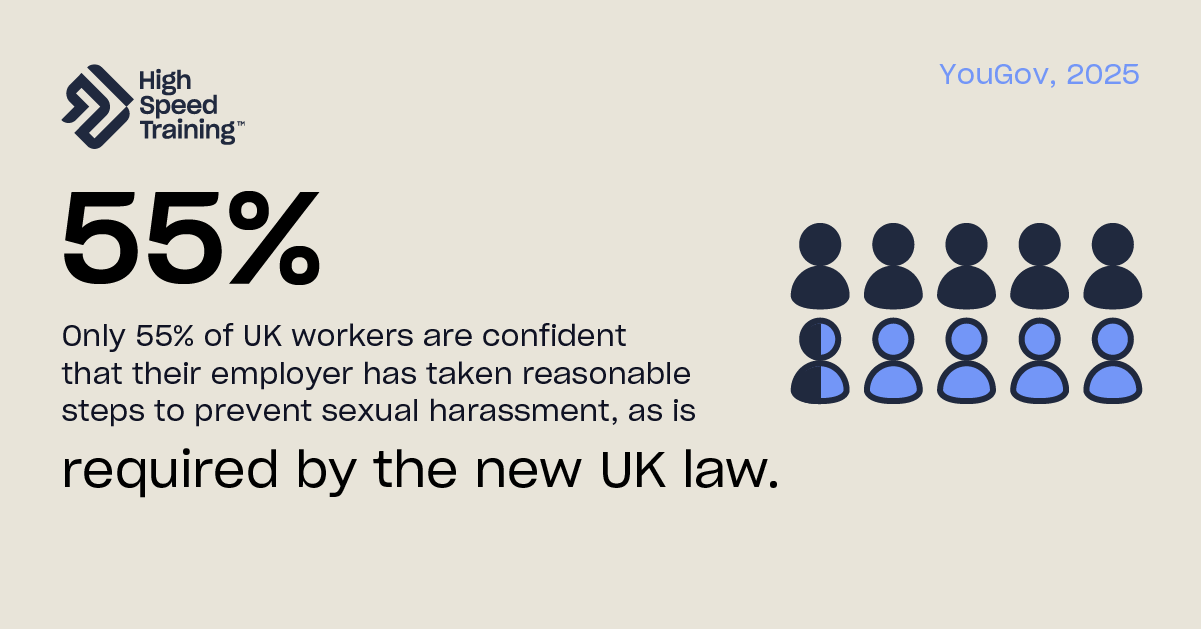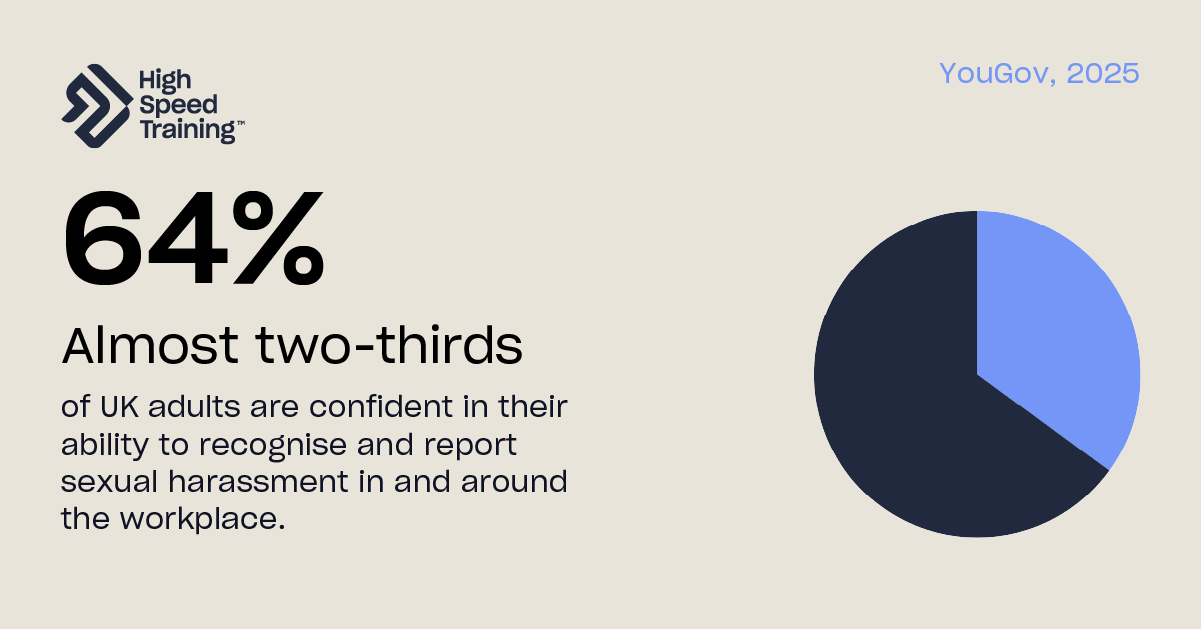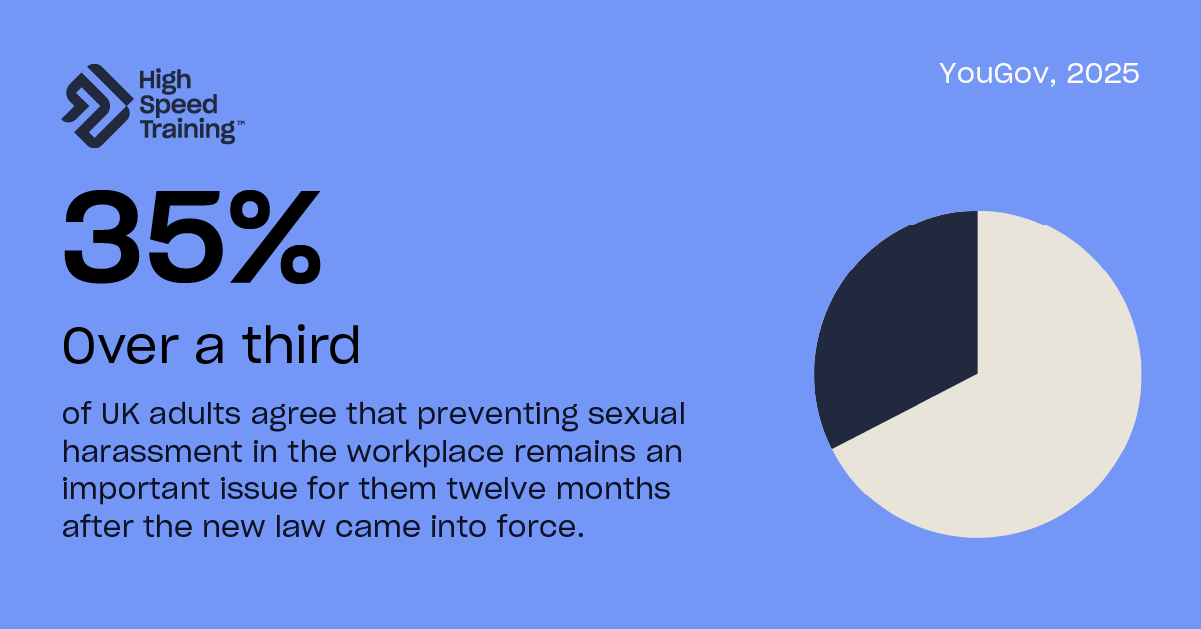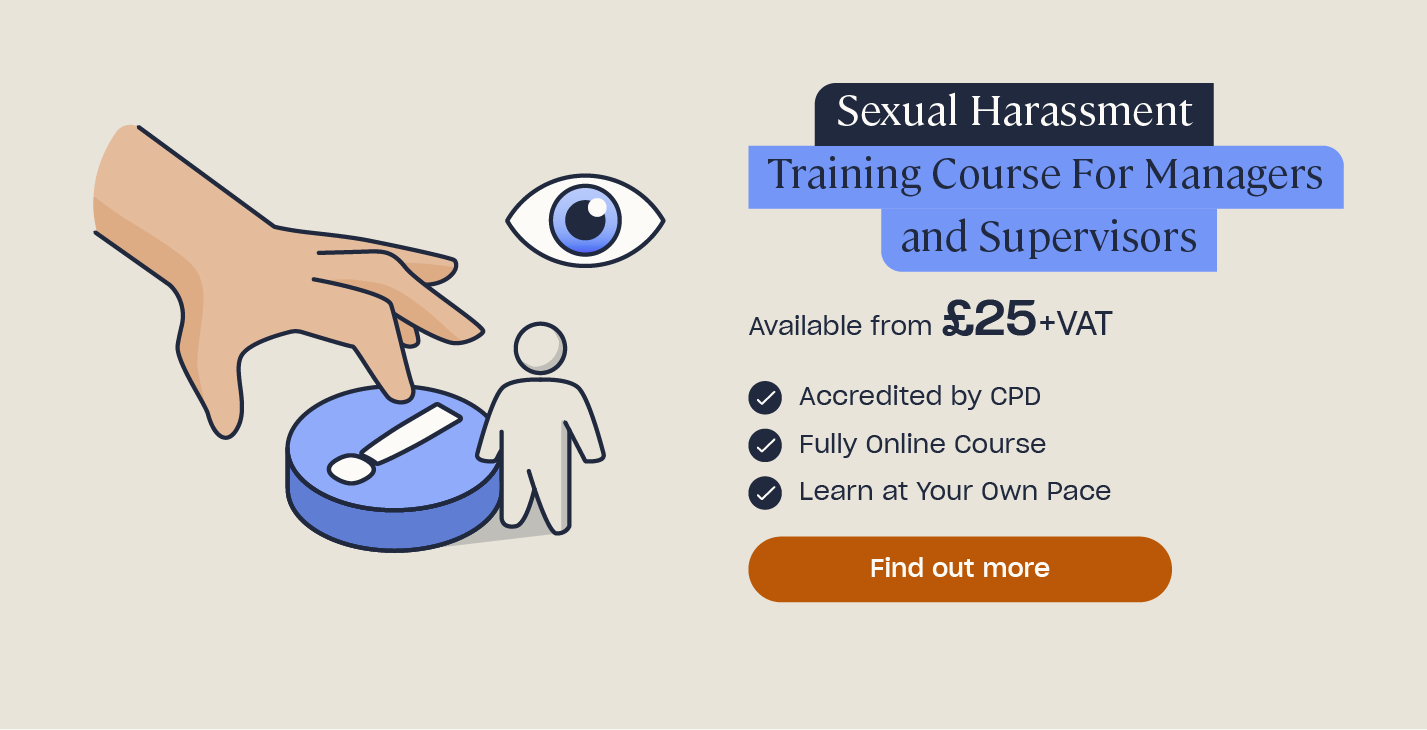Worker Protection Act & Sexual Harassment: One Year On – What Has Changed?
The Worker Protection Act (2023) officially came into force in October 2024. This landmark piece of legislation marked a significant change in how sexual harassment must be approached by employers in the UK.
This report will explore what has changed over the last year, utilising brand new data to explore attitudes towards sexual harassment in the workplace and understand what the legislation means for both employees and employers.
What is the Worker Protection Act?
The UK’s Worker Protection Act (WPA) is an amendment to the existing Equality Act 2010. The WPA introduced a legal duty for employers to take “reasonable steps” to prevent the sexual harassment of their employees. This is a proactive duty, meaning employers must act to prevent harassment, not just react to it after it has occurred.

The legislation put the onus on the employer – rather than the employee – to take action against inappropriate conduct in the workplace. It also gives workers more protection, rights and support should they experience sexual harassment when at work.
What constitutes harassment? 
The term ‘harassment’ refers to any sort of behaviour that has the purpose or effect of violating a person’s dignity or creating an intimidating, hostile, degrading, humiliating or offensive environment for that person.
The term ‘sexual harassment’ refers to any sort of unwanted conduct of a sexual nature that has this effect. Anybody who experiences unwanted sexual behaviour, whether this be verbal, physical or digital, is a victim of sexual harassment.
Some examples to look out for include:
- Comments, ‘jokes’, inappropriate remarks, emails, messages or questions of a sexual nature.
- Sexual propositions or bribes, such as offering to help a colleague at work in return for going out for a drink or on a date.
- Posting inappropriate comments on social media, such as commenting about a person’s appearance in a picture they’ve shared.
- Inappropriate hand gestures or facial expressions.
- Unwanted physical contact, including touching, hugging, unwelcome sexual advances and all forms of sexual assault.
What constitutes Reasonable Steps? 
Despite there being no official guidance of what ‘reasonable steps’ are, there are five key actions that employers can do today to help show that they’ve taken reasonable steps to prevent sexual harassment in the workplace:
- Sexual harassment risk assessment
A risk assessment involves identifying any potential risk areas, reviewing past incidents of sexual harassment and evaluating how employees currently act and feel about sexual harassment in the workplace.
A staff attitude survey to collect feedback and find out what workers really think about existing measures, such as gender equality, workplace bullying and harassment reporting procedures, can provide actionable insights to work with. The information gathered in the risk assessment process will then enable you to address problem areas. Remember to keep written records of all your actions too, as you may need it as evidence that you’ve taken ‘reasonable steps’.
- Review existing harassment policies
Your business will likely already have a formal bullying and harassment policy, so ensure it includes a section containing the definition of sexual harassment, examples of sexual harassment in the workplace and guidance for employees on what to do if they experience sexual harassment at work.
You may want to create a standalone sexual harassment policy to show that you take the topic seriously and see it as worthy of having its own procedures and guidance. This policy can then go into more detail about the business’ expectations of employees, examples of unacceptable behaviours and details of the incident reporting procedure.
- Education, education, education
In order to prevent sexual harassment from occurring, it’s vital that everyone understands what sexual harassment actually is. Employers should provide all members of staff with regular training so they can recognise inappropriate behaviours, prevent them from happening and understand what to do to address and report sexual harassment should it occur. Staff training is also a great opportunity to promote positive behaviours and encourage a culture of equality.
- Establish a ‘speak up’ culture and remove reporting barriers
Ensuring employees have an easy and efficient way to report sexual harassment is essential for improving staff wellbeing and psychological safety. Having a clear and simple reporting procedure in place is also a key ‘reasonable step’ towards preventing sexual harassment – remember to document your procedure should you need to prove this.
Establish a workplace culture where employees are encouraged to ‘speak up’ about sexual harassment, and demonstrate that your reporting procedure is free from barriers, otherwise incidents may go unreported. This means ensuring employees can trust you’ll take their report seriously, that you’ll take swift appropriate action once a report is made and that staff are reassured that they won’t face repercussions for speaking up.
- Set the tone from the top down
You need to walk the walk and talk the talk. This means setting the right example at all levels of the business, from senior management down to line managers and supervisors, by living the values you’ve established and behaving in the way you expect your employees to.
Everyone at all levels of the business should be trained in sexual harassment so they feel confident to challenge it and speak up about it. Managers and senior leaders should promote a culture of dignity and respect, set the tone for expected behaviour and challenge ingrained attitudes that are known to be problematic. If workers can see that senior management take sexual harassment seriously, then they’re much more likely to follow suit.
New research explores public attitudes towards sexual harassment
One year on from the Worker Protection Act coming into force, High Speed Training wanted to explore attitudes towards sexual harassment and the new legislation. Are employers fulfilling their new obligations? How have things changed over the last year? Were people concerned about the topic of sexual harassment in the workplace?
We commissioned a YouGov survey of over 2,200 UK adults to explore these topics. For more information on the survey, see ‘Methodology’ at the bottom of the report.
Confidence in employers
As we’ve learnt, the WPA introduced the legal duty for employers to take “reasonable steps” to prevent sexual harassment. As this change places the onus on the employer, we wanted to explore if respondents felt confident that their employer had achieved this.
Of the people surveyed, only 55% of UK workers are confident that their employer has taken reasonable steps to prevent sexual harassment, as is required by the new UK law. These results were broadly similar across demographics such as age and gender.

These figures show that there is work to be done by UK employers to not only take the steps as required by law, but effectively communicate them to their employees and foster positive workplace relationships.
Alongside this, we wanted to explore feelings towards the reporting of sexual harassment, specifically if they felt that their employer would be able to effectively handle a report of sexual harassment.
The figures made for stark reading, with only 62% of UK workers reporting that they had confidence in their employer to handle such a report effectively.

However, when asked if they themselves could recognise and report sexual harassment in and around the workplace, 64% of respondents felt confident they could do so.

This disparity highlights a gap in confidence between employees and employers, which is something that workplaces would do well to address to create a safe and effective culture in their workplaces. This inequality in confidence could lead to instances of sexual harassment not being properly addressed, either because they are not reported, or are handled ineffectively.
Sexual Harassment – a continuing concern
A crucial question to ask one year on from the introduction of the WPA is about the impact on employees, and their personal attitudes towards sexual harassment. Have the new measures affected their perception, or has it faded into the background of business-as-usual?
Our data clearly shows that sexual harassment remains a matter of significant concern for employees.
The research found that over a third of UK adults (35%) agree that preventing sexual harassment in the workplace remains an important issue for them twelve months after the new law came into force. This demonstrates that the changes are addressing a real and pressing concern for a significant portion of the UK workforce. This should be of particular note to employers, as a sizeable number of their colleagues are likely to view steps taken to eliminate sexual harassment as incredibly important.

This sense of urgency is borne out by further findings. We found that 1 in 5 (20%) of adults surveyed are actively concerned about sexual harassment at the workplace. This is an alarming figure, suggesting that a fifth of the UK workforce are carrying concerns that can impact their well-being, collaboration, and overall psychological safety. If such a high percentage of people in a workplace are feeling apprehensive about their work environment, it presents a clear barrier to creating safe and inclusive workplace cultures.

Unfortunately, our research suggests that these concerns may be rooted in reality. Of the UK adults surveyed, we found that one in ten (10%) workers have witnessed behaviour at their workplace in the last 12 months that they would consider to be sexual harassment.

Expanding the overall findings to the UK workforce, which the ONS estimated to be 36.9 million people in December 2024, these findings would suggest that nearly 3 million people have witnessed sexual harassment in the workplace in the last 12 months, underlining the need for the new legislation, and showing just how much work employers need to do to ensure that everyone feels safe and supported at work.
While our headline figure shows that 8% of all UK adults have witnessed sexual harassment at work in the last year, a deeper look into the age demographics reveals a striking disparity. The data shows a clear generational divide, with respondents aged 18-24 more than three times as likely to have witnessed such behaviour as those aged 45 and over (18% vs 5%).
What lies behind the generation divide?
The figures suggest that younger employees are either being disproportionately exposed to or witnessing sexual harassment, or are more adept at recognising inappropriate behaviour.
Younger generations have entered the workforce in a post #MeToo era, in a world with a clearer and broader understanding of what constitutes unacceptable behaviour. Actions once considered workplace banter or jokes may now be correctly identified by younger employees as inappropriate behaviour.

Younger workers are also more likely to occupy more junior or entry-level positions, which could make them more vulnerable to inappropriate conduct, and feel less empowered to challenge it.
It’s likely to be a mix of these two factors, but this clear discrepancy must act as a wake-up call for employers. It suggests that senior leaders’ perception of their workplace environment may fundamentally differ from that of their employees, especially those of a younger age. To truly create a harassment-free workplace, employers must listen to the experiences of their entire workforce and ensure their policies and training address the day-to-day realities.
How training bridges the trust gap
It’s clear that a gap exists between employees’ attitude towards, and awareness and experience of, sexual harassment, and their confidence in their employers to prevent and deal with it. So, how can businesses bridge this gap, embrace their new responsibilities and move towards active prevention?
A strong workplace culture, one that promotes transparency, trust and inclusivity, is built by visible and consistent action and investment. For organisations looking to demonstrate their commitment, comprehensive sexual harassment awareness training is a great place to start.
Thousands of UK businesses are already recognising this. Since the WPA came into force 12 months ago, High Speed Training has seen more than a 1,500% increase in companies enrolling teams on its Sexual Harassment Training for employees course, with a 2,234% increase in uptake of their Sexual Harassment Training for managers course.
Beyond the tick-box – Effective training in action
Many of us will have taken some form of training in the course of our careers, whether it be manual handling, food hygiene or health and safety. All of these serve a purpose, and help to ensure that our workplaces, and the colleagues we share them with, are as safe as possible.
When it comes to sexual harassment, training helps to achieve key objectives for organisations.
• Effective training ensures everyone, regardless of their experiences, seniority and role, shares common understandings of what sexual harassment is, clarifies grey areas and reinforces processes and policies.
• Training helps to empower the whole workforce, not just people who may have been the victims of sexual harassment, giving the whole team the confidence and skills to report behaviour that may be inappropriate.
• An effective training programme helps to build trust and credibility in employers, demonstrating a commitment to tackling a problem that concerns a significant portion of the workforce.
• A robust and provable training programme also provides an important legal safeguard, as a well-documented and regularly refreshed training programme is one of the most concrete pieces of evidence an employer can provide to demonstrate they have taken the “reasonable steps” required by the Worker Protection Act.
Methodology
All survey figures, unless otherwise stated, are from YouGov Plc. Total sample size was 2208 adults. Fieldwork was undertaken between 29 th to 30th September 2025. The survey was carried out online. The figures have been weighted and are representative of all UK adults (aged 18+).
Further Resources:
- Sexual Harassment Training For Employees
- Sexual Harassment Training Course For Managers and Supervisors











